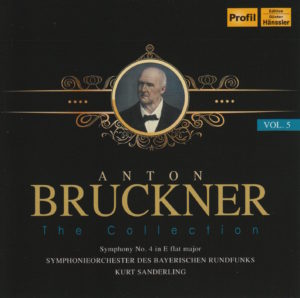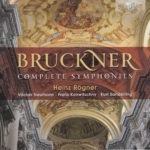 This morning’s conductor of Anton Bruckner’s Symphony No. 4 in E Flat Major (WAB 104), titled “Romantic” by Bruckner himself, is German-born Kurt Sanderling (1912-2011), another person about whom I knew nothing and of whom I had never heard until I started this project.
This morning’s conductor of Anton Bruckner’s Symphony No. 4 in E Flat Major (WAB 104), titled “Romantic” by Bruckner himself, is German-born Kurt Sanderling (1912-2011), another person about whom I knew nothing and of whom I had never heard until I started this project.
This is the second time I’ve listened to Maestro Sanderling.
The first time was on Day 44.
Both times – today and on Day 44 – I didn’t exactly choose to listen to him.
 I heard Mr. Sanderling on Day 44 because he was in the Bruckner box prominently titled Heinz Rogner, from which I discovered (on Day 28) Franz Konwitschny and, (on Day 12) Vaclav Neumann.
I heard Mr. Sanderling on Day 44 because he was in the Bruckner box prominently titled Heinz Rogner, from which I discovered (on Day 28) Franz Konwitschny and, (on Day 12) Vaclav Neumann.
The first time I opened the Bruckner Complete Symphonies box, I thought the conductor was going to be Heinz Rogner. Can you blame me? The largest name on the cover of the box set is Heinz Rogner. So, naturally, I positioned that box set after the Paternostro performance (R comes after P, you see). However, I quickly realized that the box set – released by the extraordinary Brilliant Classics label – only listed Heinz Rogner’s name larger than the others, giving the impression that it was a Heinz Rogner-conducted series of Bruckner symphonies.
As it turns out, Sanderling happens to come after Paternostro and before Skrowaczewski, anyway. So the appearance of Sanderling’s name in the listening order on Day 44 probably went unnoticed.
 For the same reason why I positioned the Rogner-named collection in the “R” order of the alphabet, I put the Bruckner Collection box set under “C” in the listening order – even though the set contains (as I discovered) recordings from various conductors.
For the same reason why I positioned the Rogner-named collection in the “R” order of the alphabet, I put the Bruckner Collection box set under “C” in the listening order – even though the set contains (as I discovered) recordings from various conductors.
Today, who should pop up? Not a conductor with a “C” name. Or even one with a name in close proximity to the letter “C.” Rather, it was Kurt Sanderling. Cool. Bring it on.
I’ll save the subjective comments for the end. First, the nuts and bolts:
Bruckner’s Symphony No. 4 in E Flat Major composed in 1874
Kurt Sanderling conducts
Sanderling used the 1878/1880 version
Symphonieorchester des Bayerischen Rundfunks plays
The symphony clocks in at 71:01 (Which qualifies it for the YIKES! Award)
Where this was recorded is unknown. Germany would be my guess. When, however, is known: 1994
Sanderling was 82 when he conducted it
Bruckner was 50 when he composed it
This recording was released on the Profil/BR Media label
Bruckner wrote his symphonies in four parts. The time breakdown of this one (Symphony No. 4 in E Flat Major, 1878/1880 edition), from this particular conductor (Sanderling) and this particular orchestra (Symphonieorchester des Bayerischen Rundfunks) is as follows:
I. Bewegt, nicht zu schnell (With motion, not too fast) (E-flat major)…………..20:04
II. Andante, quasi allegretto (C minor)…………………………………………………………..16:22
III. Scherzo. Bewegt (With motion) – Trio: Nicht zu schnell (Not too fast) (B-flat major)……………………………………………………………………………………………………………….11:31
IV. Finale: Bewegt, doch nicht zu schnell (With motion, but not too fast) (E-flat major)………………………………………………………………………………………………………………23:03
Total running time: 71:02
Okay. Now for the subjective stuff…
My Rating:
Recording quality: 4
Overall musicianship: 4
CD liner notes: 0 (there are none; boo! hiss!)
How does this make me feel: 3
This is a recording that falls squarely in the “Meh” category.
It’s not great. It’s not terrible. It doesn’t seem to grab me in any way.
Of the version Sanderling chose (1878/1880), its entry on Wikipedia reads,
1880 version (aka 1878/1880)
After the lapse of almost a year (during which he composed his String Quintet in F Major), Bruckner took up his Fourth Symphony once again. Between 19 November 1879 and 5 June 1880 he composed a new finale – the third, though it shares much of its thematic material with the first version – and discarded the Volksfest finale. Thus the 1880 version is the same as the 1878 version but with a new finale. This was the version performed at the work’s premiere on 20 February 1881, which was the first premiere of a Bruckner symphony not to be conducted by Bruckner himself. This version is sometimes referred to as the 1878/80 version.
Now, you see, what liner notes tell us is why a conductor would choose one version over another.
Why did Maestro Sanderling decide the 1878/1880 version was the one to conduct?
I guess we’ll never know.
This box set doesn’t tell us.
But, back to the music.
Not even the lively “Hunt”-themed Third Movement (Scherzo) stirs me.
For that matter, neither does the (what’s supposed to be rousing) Finale.
No “Huzzah!” from me this time around.
Everything is extraordinarily competent, marvelously average.
The recording itself is okay. But the orchestra lacks depth. It all sounds the same to my ears. I’m not hearing a complexity of instruments.
Again, none of what I just wrote is objective. This recording does not suck. Sanderling is not incompetent.
All I’m typing are my opinions about how, for the most part, the music makes me feel.
And, for a piece of music that tops 71 minutes, this needed to knock my socks off, fling them across the room, maybe even wash them, fold them, and put them back in my drawer – but not before putting new socks on my feet, handing me my pipe, and putting a creased, crisp newspaper in my hands, and a martini by my side.
It didn’t.
But that’s okay.
Music – as all art – is wholly subjective. So your mileage may vary.
